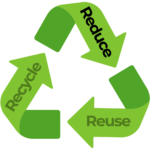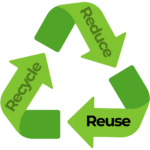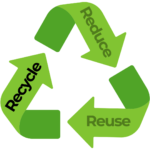 Earth Day: Reuse or Recycle
Earth Day: Reuse or Recycle  Your Car Seat?
Your Car Seat?

![]()
![]()
![]()
![]()
![]()
How Can We Protect Planet Earth  While Having to Use So Much Baby Gear at the Same Time?
While Having to Use So Much Baby Gear at the Same Time?
Earth Day is here and it’s important to all of us to maintain our planet so our children can grow up to enjoy its beautiful resources and benefit from its bounty. But with all the baby gear that goes along with having a little one, how can you decide what you truly need and how to get rid of it when you’re done?
Since we are carseat experts, we’re going to focus on carseats here. The first thing you need to know is that carseats are safety devices. They are designed to protect your child from injury or death in a sudden stop or crash. That may seem really obvious, but keep that in the back of your mind for now because it’s easy to lose sight of when you’re trying to make ends meet or reduce waste.
Reduce. Reuse. Recycle.
We hear these three words a lot around Earth Day, so let’s look at how we can Reduce, Reuse, and Recycle when it comes to child passenger safety.
Reduce.
How can we reduce when it comes to carseats? Kids need to use carseats, right? Yep. And don’t think about skipping the booster either, because that’s a very needed step as a child grows older and larger. Here are some ways to reduce usage in carseats, though admittedly, there’s not a lot you can safely do to reduce with carseats:
Infant Stage
 Start out with a convertible (rear-facing/forward-facing) or all-in-one (rear-facing/forward-facing/booster) carseat instead of a rear-facing only infant seat. The vast majority of convertibles/all-in-ones start at 5 lbs. (some start at 4 lbs.), so they will fit small infants. It’s a fallacy that you absolutely need the infant seat or that a hospital requires you to have one for discharge. It may be recommended, but that’s not the same as required.
Start out with a convertible (rear-facing/forward-facing) or all-in-one (rear-facing/forward-facing/booster) carseat instead of a rear-facing only infant seat. The vast majority of convertibles/all-in-ones start at 5 lbs. (some start at 4 lbs.), so they will fit small infants. It’s a fallacy that you absolutely need the infant seat or that a hospital requires you to have one for discharge. It may be recommended, but that’s not the same as required.
However, some convertibles/all-in-ones may start at 5 lbs., but they may not fit tiny babies well. This is where doing some research first—reading reviews by trained experts and taking a small doll to the store to try the carseat—will help. If you don’t feel comfortable with the fit of a convertible carseat, by all means, use an infant seat—and if you have a preemie, you’re guaranteed to need an infant seat that fits preemies well. You can cut back in other areas of your life.
Toddler (2+)/Preschool Stage
Be forward-thinking. If your child needs a new carseat, think about the stage they’re in right now, but also what you think you may do with the carseat in the future. Will they have a younger sibling who will use the carseat? If that’s the case and they are already forward-facing, buying an all-in-one carseat that has rear-facing capabilities may make sense. If the seat won’t be handed down to a smaller sibling, that doesn’t make sense and a forward-facing only seat may be more cost-efficient.
Booster Stage
This is the end stage of carseats and boosters take a lot of beating. A lot. Even the nicest boosters end up looking like they’ve been dragged behind the car. If your child is comfortable using a booster and doesn’t sleep in the car, a backless booster works just fine.
Reuse.
Can we reuse carseats? This is a loaded question that has many branches to the answer. Let’s break it down.
Yes, if:
It’s handed down from a sibling/family member
Hasn’t expired
Wasn’t in a crash as defined by the manufacturer
Has been washed according to manufacturer instructions
Has no recalls or has had recalls repaired
Yes, if:
It’s from a trusted friend
Hasn’t expired
Wasn’t in a crash as defined by the manufacturer
Has been washed according to manufacturer instructions
Has no recalls or has had recalls repaired
No, if:
It’s from a marketplace, like FB Marketplace, OfferUp, eBay, GoodBuy Gear, resale store, etc.
No, if:
It’s from a garage sale, yard sale, rummage sale, etc.
Ask yourself: Do I trust the person selling me this carseat with my child’s life? They’re there to sell you a carseat to get it out of their life. They want it gone. What’s their motivation? Remember, this is a safety device designed to save your child’s life. You want it in tip-top shape, so purchasing the $80 brand-new carseat with less padding at the store is better than buying the $150 used carseat with all the trimmings from someone you don’t know.
It may be missing labels you need to see but don’t know to look for, or important parts.
That carseat that’s 20 years old that was stored in someone’s basement/attic/garage but looks in perfect condition because it was only used twice for the grandkids? Yeah, it’s a deathtrap.
Plastic degrades over time. Manufacturers put additives in plastic to give it strength for its designated purpose for a particular amount of time. Is a safety device really where you want to cut corners?
Recycle.
There are recycling programs for carseats and some manufacturers will help you with the process.
Ten years ago, Clek became the first carseat manufacturer to recycle their carseats. Now they’ve partnered with CarSeatRecycling.com to recycle all carseats.
You can also check with your local recycling company to see if they accept carseats. Some do!
Twice a year in April and September, Target partners with the Waste Management company for the Trade-In Event. Our Target Trade-In Event article has all the info you could possibly want on the event and as soon as the next dates are announced, we let you know too.
There you have it: three different ways to lighten the burden on our planet and I didn’t even mention the steps some manufacturers are taking by making sure they’re leaving behind a greener planet—there are many!
We are affiliate partners with Target, which means we earn a very small percentage at no cost to you if something happens to jump into your cart when you click through one of our Target links. We do appreciate you spending time here and thank you! Here’s our marketing disclosure.







